12/06/2018
Turpin Robert J.
 First taste of freedom
First taste of freedom
A cultural history of bicycle marketing in the United States
Auteur : Robert J. Turpin
Réflexions sur les comportements changeants des Américains vis à vis de la bicyclette.
« Parmi les historiens du vélo, cela a longtemps été une énigme : Pourquoi les Américains - et seulement les Américains - se sont-ils moqués du cyclisme pour adultes pendant une grande partie du XXe siècle ? Au cours de cette enquête importante et pertinente, Robert Turpin entre dans la tête des distributeurs de l'industrie du cyclisme qui sont largement responsables de ce comportement : il a suivi leur logique lorsqu'ils associent par hasard et identifient le vélo à une icône de l'enfance américaine. Turpin présente une vision élargie des formes changeantes du vélo et de son importance à travers ses 200 ans d'histoire et il raconte un intéressant récit de marketing, de virilité et de conséquences imprévues.» Margaret Guroff, auteur de « The Mechanical Horse : How the bicycle Reshaped American Life ».
« Le convaincant nouveau livre de Robert Turpin explore l'évolution du vélo au cours du XXe siècle, passant d'un objet de loisir pour adultes à un jouet pour enfants. Les historiens des affaires, du consommateur et du vélo accueilleront chaleureusement ce livre remarquable. » Thomas Burr, Professeur agrégé à l'université d'état de l' Illinois.
Comme une lentille pour observer l'histoire américaine, ce récit sur la bicyclette approfondit notre compréhension de notre culture nationale et les forces qui l'influencent.
Robert J. Turpin est maître assistant d'histoire à l'université Lees-McRae en Caroline du Nord.
2018 – 224 pages – Syracuse University Press
Prix : $27.95 couverture souple
Livre en anglais, traduction d'Isabelle Reutin
16:07 Écrit par Biblio-cycles dans Anthologie - Traités - Essais - Biographies, Livre en anglais | Lien permanent | Commentaires (0) |  Imprimer
Imprimer
27/03/2018
Woodland Léo
 Sticky Buns Across America
Sticky Buns Across America
Back-roads biking from sea to shining sea
Auteur : Léo Woodland
Il est très inhabituel pour un récit de voyage de faire figurer la carte en page 1 de couverture. Et en plus, celui-là m’inspirait beaucoup : il suivait sur une bonne partie le cheminement de l’expédition de Lewis & Clarke, la première traversée est-ouest du continent par des Américains, en remontant le Missouri. J’avais adoré leur récit, une véritable aventure d’exploration vécue, pleine de couleurs et de description de l’Amérique indigène. J’ai cependant dû attendre les toutes dernières pages du récit de Léo Woodland pour lire la première allusion aux deux héros du mythe fondateur des USA. Il en est beaucoup plus critique que moi puisqu’il y a davantage vu le récit d’une conquête militaire. Léo avait auparavant fait allusion à deux autres auteurs sans les critiquer, peut-être parce qu’ils l’ont inspiré dans sa description de la campagne américaine. Deux auteurs qui m’avaient moi-même beaucoup influencé. Il s’agit de Josie Dew, écrivaine prolifique dont la caractéristique, qu’on me pardonne mais cela m’est apparu suffisamment curieux pour que je relève, est d’attirer les exhibitionnistes comme la bière les guêpes. L’exhibitionnisme est une perversion sexuelle que j’ai toujours beaucoup de mal à comprendre (à l’inverse des autres), et qu’on jugerait imprudemment sans danger. En effet Josie Dew fut séquestrée dans un appartement en étage, dont elle a dû s’échapper par une fenêtre. En Bulgarie si ma mémoire est bonne.
Le deuxième est William Least Heat Moon, dont le récit d’un tour des USA en camping-car en ne suivant que les « routes bleues » (l’équivalent de nos routes blanches Michelin) resta plusieurs mois un best-seller dans les années 1982-83.
Léo a les mêmes centres d’intérêt (hormis les exhibitionnistes...), c’est un documentariste cultivé. Je me demande comment il a pu prendre autant de notes sur tous les villages que lui et son épouse Steph ont traversés et où il a remarqué quelque chose de surprenant, d’inédit, d’humoristique ou de typiquement américain. En effet, la situation de ce couple n’est pas commune : nés et élevés au Royaume Uni, ils sont venus prendre leur retraite dans le Sud-Ouest et ont la nationalité française. Les voilà donc, parfaitement anglophones mais officiellement français, à traverser les États-Unis, ce qui n’est vraiment pas banal et vaut au lecteur un point de vue totalement unique, qu’aucun Français ou qu’aucun Britannique n’aurait pu fournir. Il faut donc toutes affaires cessantes lire ce livre.
Un détail à son sujet, il est en anglais, mais je ne doute pas que, chez les voyageurs à vélo, tout le monde maîtrise cette langue. Cherchez, pour vous mettre l’eau à la bouche, si j’ose, le double-sens d'une partie de son titre : « sticky buns ».
Note de lecture spontanée proposée par Bernard-Régis Magnouloux
2012 – 212 pages - MacGann Publishing
Prix : $16.95 US
17:38 Écrit par Biblio-cycles dans États-Unis, Livre en anglais | Lien permanent | Commentaires (0) |  Imprimer
Imprimer
10/03/2018
Kirsch Colin
 Bad Teeth No Bar
Bad Teeth No Bar
A history of military bicycles in the Great War
Auteur : Colin Kirsch
Quand la Première Guerre mondiale a commencé, la bicyclette était encore une invention relativement récente - le grand-bi avait depuis peu cédé la place à la bicyclette, un engin plus souple, rapide et sûr ; et alors que les bicyclettes et la pratique du vélo n'étaient plus autant à la mode que dans les années 1890, elles étaient pourtant toujours un indicateur fiable de la vie moderne. Il n'est donc pas surprenant que les bicyclettes aient été rapidement mises en service au début des hostilités. À une époque où les armées européennes pratiquaient encore les charges de cavalerie avec des chevaux, et où le rôle du transport motorisé en temps de guerre n'était pas encore très clair, les cyclistes étaient appelés à jouer différents rôles auprès des armées des deux côtés, y compris comme messagers , éclaireurs et guides.
Le livre « Bad Teeth No Bar », qui tire son nom d'une publicité demandant aux cyclistes de s'engager comme volontaires dans l'armée, illustre magnifiquement le rôle joué par les bicyclettes dans la Grande Guerre. Plein de photographies couleur de vélos d'époque et de leurs propriétaires, illustrant les récits de leurs exploits oubliés depuis longtemps, ce livre éclaire un aspect peu connu de la guerre et célèbre un certain nombre de héros méconnus. Idéal à la fois pour les amateurs de vélos d'époque et pour les passionnés d'histoire militaire, « Bad Teeth No Bar » est une remarquable commémoration du centenaire.
2018 – 400 pages – The University of Chicago Press Books
Prix : $45.00
Livre en anglais, traduction d'Isabelle Reutin
17:18 Écrit par Biblio-cycles dans Cyclisme militaire, Histoire, Livre en anglais | Lien permanent | Commentaires (0) |  Imprimer
Imprimer
Fitzpatrick Jim
 The bicycle in wartime
The bicycle in wartime
An illustrated history
Auteur : Jim Fitzpatrick
« Une vision d'ensemble détaillée et d'une très grande variété sur l'utilisation des bicyclettes en temps de guerre.
Jim Fitzpatrick montre de façon convaincante à quel point les experts se sont totalement trompés en sous-estimant l'influence de la bicyclette, même lorsqu'elle était utilisée contre des armées très mécanisées. Un livre passionnant et qui vaut la peine d'être lu » selon David Gordon Wilson, professeur émérite d'ingénierie au MIT, auteur de « Bicycling Science. ».
« Une lecture fascinante et captivante, complétée par une multitude de photographies d'archives. Plus important encore, le livre rassemble l’aspect stratégique de la politique militaire et les expériences des cyclistes sur le terrain. » selon Paul Rosen, Université de York.
« Dans ce remarquable tour de force, l'auteur Jim Fitzpatrick a, pour la première fois, retracé l'histoire de la bicyclette en temps de guerre. Sa contribution est importante et résistera à l'épreuve du temps ... les forces militaires du monde entier ont longtemps été conscientes du potentiel de la bicyclette. À certaines occasions, elle a fait la différence entre la victoire et la défaite : les Japonais en Malaisie, les forces Viet Minh du général Vo Nguyen Giap à Dien Bien Phu. » selon Cecil B. Currey, auteur de « Victory at any cost : le génie du général vietnamien Vo Nguyen Giap ».
2011 – 272 pages – Star Hill Studio
Prix : $28.95 en Australie ; disponible sur Amazon pour les autres pays.
Nouvelle édition d'un livre paru en 1998 chez Brassey's 
Livre en anglais, traduction d'Isabelle Reutin
Plusieurs autres titres en rapport avec la bicyclette sont au catalogue de cet éditeur.
17:11 Écrit par Biblio-cycles dans Cyclisme militaire, Histoire, Livre en anglais | Lien permanent | Commentaires (0) |  Imprimer
Imprimer
19/10/2017
Nowak Kazimierz
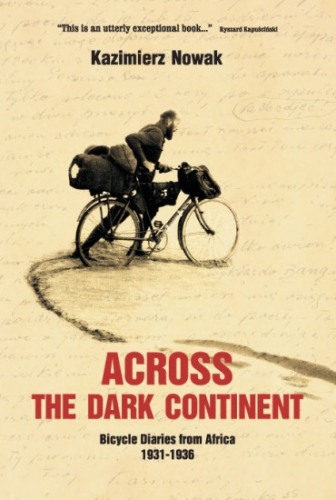 Across The Dark Continent
Across The Dark Continent
Bicycle Diaries from Africa 1931-1936
Auteur : Kazimierz Nowak
English edition of the bestseller « Rowerem i pieszo przez Czarny Ląd ».
A solitary traveller moves tirelessly forward. His path leads him through breathtaking landscapes, past picturesque waterfalls, smoking volvanoes, countless herds of wild animals reigning over boundless spaces, through desert sand, the barren savannah and overgrown forest trails. He stops from time to time to take a photograph or make a note in his journal, and then moves on again, pushing his rickety bicycle loaded with some modest possessions. This is Kazimierz Nowak, the author of this story which, like a fairytale, transports us to a wonderful kingdom, distant in both space and time : Africa in the 1930s.
Livre en anglais dont nous avions présenté l'édition polonaise de 2011. À quand une traduction en français ?
2017 – 394 pages – Sorus
Prix : 49,50 zł
21:39 Écrit par Biblio-cycles dans Afrique, Livre en anglais | Lien permanent | Commentaires (0) |  Imprimer
Imprimer
28/06/2017
Agudo Shirley
 The Dutch & their bikes
The Dutch & their bikes
Scenes from a nation of cyclists
Auteure : Shirley Agudo
The best collection of Dutch cycling photos ever assembled!
For more than a decade, American photographer and author Shirley Agudo has been photographing the incomparable bicycle culture of the Netherlands, where she now lives. Following the success of her previous book, Bicycle Mania Holland, she has amassed this new collection of 400 photos—The Dutch & their Bikes: Scenes from a Nation of Cyclists.
It’s the definitive photo guide to the world’s best bicycle culture.
For the Dutch, cycling is a way of life. With more bikes than people, the Netherlands is a nation of cyclists where children virtually learn to cycle before they learn to walk. Everyone cycles, every day and everywhere. What they carry and do on their bikes is unbelievable.
Agudo’s fascinating photo anthology offers a privileged look at this culture that lives and breathes cycling.
Hold your breath for the ride.
Livre en anglais signalé par Claude Marthaler
2017 – 352 pages – Xpat Scriptum Publishers
Prix : $ 29.95
22:19 Écrit par Biblio-cycles dans Livre en anglais, Pays-Bas, Photographies | Lien permanent | Commentaires (0) |  Imprimer
Imprimer
14/06/2017
Van den Berg Eric
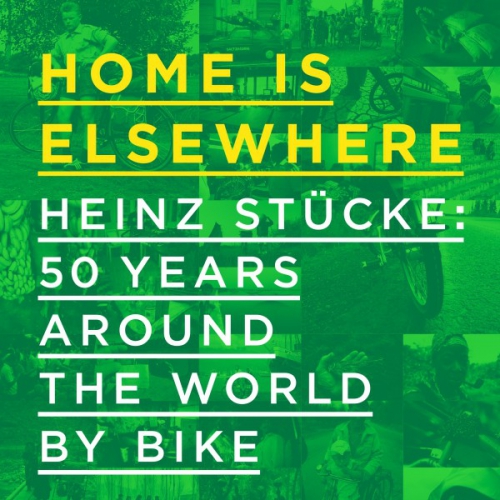 Home is elsewhere
Home is elsewhere
Heinz Stücke: 50 years around the world by bike
Auteur : Eric Van den Berg
Photographies : Heinz Stucke
Heinz Stücke is back where he started : in Hövelhof, the German village he happily cycled away from half a century ago. He visited 196 countries, got through 21 passports, and ended up with a tidy number of 100,000 photos to sort out. He came across Pelé, got pocket money from Haile Selassie, and even slept under the arms of Christ the Redeemer. He cycled more than 648,000 kilometres, most of them on an ordinary gents’ bike, and several thousands on a Brompton folding bike.
Heinz ‘wanted to see it all’. Dutch travel writer Eric van den Berg, who dug into his vast collection of journals, photos, postcards and notes, visited the now 75 year old cyclist to get an answer to that most pressing question: why? His philosophy of ‘home is elsewhere’ comes through in the daily routines, unexpected encounters and inevitable mishaps of a lifelong adventurist and Einzelgänger, and not least through the pictures Heinz took himself.
2015 – 176 pages – Édité par Brompton Bicycle Ltd
Prix : £15.00
Livre en anglais.
Il existe également une brochure en français, parue en 1999, sur les voyages de cet extraordinaire personnage.
18:08 Écrit par Biblio-cycles dans Livre en anglais, Tour du Monde | Lien permanent | Commentaires (2) |  Imprimer
Imprimer
23/02/2017
Moore Tim
 The Cyclist Who Went Out in the Cold
The Cyclist Who Went Out in the Cold
Adventures Along the Iron Curtain
Auteur : Tim Moore
Commentaire de Jean-Yves Mounier
Encore un écrivain voyageur qui va nous faire regretter de ne pas mieux maîtriser la langue de Shakespeare...
Sur un vieux vélo pliable MIFA datant de la RDA , Tim va s'élancer sur l'Eurovélo13 - Iron Curtain Trail au mois de mars en partant du point le plus septentrional du parcours pour arriver 10 000 kilomètres plus loin sur les bords de la Mer Noire.
Les projets originaux, Tim Moore sait en élaborer sur sa bicyclette : en 2001, il publie son aventure sur le parcours du Tour de France, en 2014, il nous raconte comment il a refait sur vélo et costumes d'époque le parcours du très difficile Giro de 1914 qui, sur 81 participants au départ, n'en vit arriver que 8.
Le voyage de Tim Moore le long du Rideau de Fer a fait l'objet de nombreux articles sur internet, nous vous recommandons, pour les francophones, celui-ci et pour les anglophones, celui-là.
Livre en anglais. À quand une édition française qui reprendrait ces superbes couvertures ?
2016 – 352 pages – Yellow Jersey Press
Prix : £14.99


12:13 Écrit par Biblio-cycles dans Europe, Livre en anglais | Lien permanent | Commentaires (0) |  Imprimer
Imprimer
08/02/2017
Thomas Edward
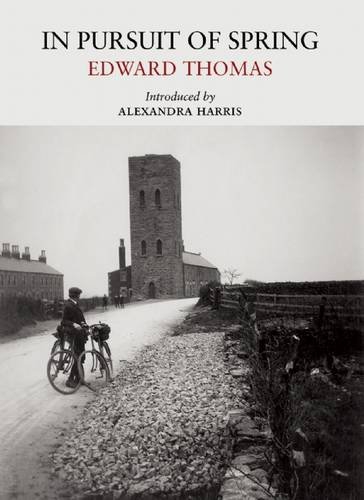 In Pursuit of Spring
In Pursuit of Spring
Auteur : Edward Thomas
En mars 1913, alors que les nuages menaçants de la Grande Guerre s'amoncellent, Edward Thomas part à vélo de Clapham (Quartier de Londres) aux Collines Quantock dans le Somerset. Le grand poète a raconté son voyage à travers des photos et des carnets. Il les a publiés plus tard dans “ In Pursuit of Spring ” (À la poursuite du Printemps ), un livre actuellement considéré comme sa meilleure œuvre en prose. Edward Thomas n'est pas connu pour ses photographies, mais ces images bien cachées dans des archives depuis plusieurs années, témoignent très précisément de ce qu'il a vu – à Guildford, Winchester, Salisbury, à travers la Plaine, jusqu'au Canal de Bristol – et associent les pensées et les sentiments du poète dans une élégie mélancolique d'un monde maintenant disparu.
Les éditions Little Toller sont enchantées d'avoir découvert ces photographies et de pouvoir les publier pour la première fois.Préfacée par Alexandra Harris, l'auteur renommé de “ Weatherland ”, “ Romantic Moderns ”, la nouvelle édition de “ In Pursuit of Spring ” de chez Little Troller sera publiée le 3 mars, jour de l'anniversaire d'Edward Thomas, et contiendra plus de cinquante photographies prises pendant son voyage.
En 2014, pour commémorer le centenaire de “ In Pursuit of Spring ” la radio BBC Radio 4 a diffusé une série dans laquelle le présentateur Matthew Oates a suivi les pas de Thomas. Cette édition avec les photographies de l’auteur sera largement étudiée et trouvera sans aucun doute un nouveau public pour Thomas.
Edward Thomas (1878-1917) était un grand poète, un essayiste et un romancier. Probablement plus connu pour son poème “ Adlestrop ‘’, il est maintenant considéré comme une figure emblématique pour les écrits sur la campagne et les paysages.
Alexandra Harris est l'auteur de “Weatherland ”, “Modernism on Sea ”, “Virginia Woolf ” et “ Romantic Moderns ” qui a remporté le prix du Premier Livre du journal le Guardian. Elle a récemment présenté sur la Radio 4 une émission sur les promenades de Virginia Woolf. Elle donne des conférences à l'Université de Liverpool.
Lieux cités dans le livre : les comtés du sud de l'Angleterre, Clapham, Dorking, Guildford, Farnham, Alton, Winchester, Salisbury, Trowbridge, Shepton Mallet, Glastonbury, Bridgewater, Wells, Watchet.
Livre en anglais, traduction d'Isabelle Reutin
2016 – 200 pages – Little Toller Books.
Prix : £12.00
En 2015, 2 cyclistes sont partis « à la poursuite du printemps » sur les traces d'Edward Thomas et en livrent le récit sur un très beau site qui donne envie d'y aller voir...
Informations fournies par Hervé Le Cahain
11:13 Écrit par Biblio-cycles dans Angleterre, Histoire, Livre en anglais | Lien permanent | Commentaires (1) |  Imprimer
Imprimer
07/02/2017
Whiters Jeremy
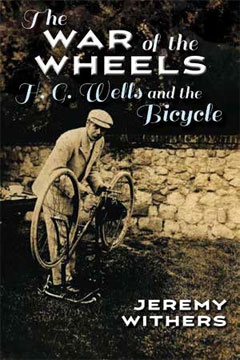 The War of the Wheels, H. G. Wells and the Bicycle
The War of the Wheels, H. G. Wells and the Bicycle
Auteur : Jeremy Withers
Le père de la science fiction et l'importance de la bicyclette dans ses œuvres.
« Withers présente au lecteur une interprétation magistrale de la passion de Wells pour la bicyclette, à la fois dans ses écrits et dans sa vie personnelle. On devrait fortement conseiller la lecture de ce livre aux historiens spécialistes du vélo et aux amateurs de Wells mais aussi à ceux intéressés par le lien entre le transport et le changement social au tournant du XXe siècle. » - Glen Norcliffe, Professeur Émérite de Géographie, à l’Université de York, Toronto.
« Dans « The War of the Wheels », la modeste bicyclette apparaît comme intimement liée aux questions d'environnement, de guerre, de changement social, de sexualité et d'écriture. L'analyse de toute une série de livres de Wells, dont beaucoup sont peu lus, est tout aussi bien venue. Jérémy Withers donne aux lecteurs de littérature victorienne et moderniste un point de vue totalement nouveau sur la technologie et la littérature, sous un angle délicieusement inattendu. » - Sarah Cole, professeur de littérature anglaise et comparée.
« Une lecture passionnante : pas uniquement sur un auteur et un moyen de transport, mais plus largement sur la modernité, l'écologie et la technologie » - Simon J. James, du Département des Études d'Anglais à l'Université de Durham.
Jeremy Withers est professeur adjoint d'anglais à l'Université d'État de l'Iowa. Il est le coéditeur de Culture on Two Wheels: The Bicycle in Literature and Film.
Livre en anglais, traduction d'Isabelle Reutin
2017 – 264 pages – Syracuse University Press.
Prix : $29.95
Information fournie par Hervé Le Cahain
14:44 Écrit par Biblio-cycles dans Anthologie - Traités - Essais - Biographies, Littérature - Poésie., Livre en anglais | Lien permanent | Commentaires (0) |  Imprimer
Imprimer
09/12/2016
Withers Jeremy & Shea Daniel P.
 Culture on Two Wheels
Culture on Two Wheels
The Bicycle in Literature and Film
Auteurs : Jeremy Withers & Daniel P. Shea
Foreword by Zack Furness
Le vélo a des identités plus culturelles que beaucoup comprennent, il ne fonctionne pas seulement dans un texte comme un véhicule au sens propre mais aussi comme un « lien » pour les thèmes, les idées et les critiques abordés dans ce même texte. À la fin du XIXe siècle la bicyclette était considérée par une riche élite citadine comme un moyen de renouer avec la nature et par les femmes comme un moyen d’obtenir un certain degré de liberté personnelle ; pendant la Seconde Guerre Mondiale c’est devenu un outil utilitaire pour la Résistance française et dans la Chine des années 70 elle représentait la richesse et la modernisation.
Récemment le vélo a eu différentes fonctions : le vecteur idéologique préféré des écologistes, un moyen de liaison dans les communautés, l’expression personnelle et esthétique dans le hip-hop et une balade de choix pour les coursiers à vélo qui idolâtrent les hipsters urbains. Le livre « Culture sur deux roues » analyse le changement de la signification culturelle de la bicyclette en étudiant ses apparitions dans des œuvres littéraires, musicales et cinématographiques à travers trois continents et sur plus de 125 ans d’histoire.
En rassemblant des essais écrits par beaucoup de cyclistes et de savants avec des angles d’approches très différents, cette collection met en évidence l’adaptabilité de la bicyclette comme quelque chose d’important ; elle analyse aussi l’apparition de la bicyclette dans des textes canoniques et célèbres comme dans le roman moderne de Samuel Beckett « Molloy », dans le film « Breaking Away » récompensé aux Oscars, dans plusieurs romans et histoires de Stephen King, aussi bien que dans des textes moins connus mais tout aussi significatifs comme le film « Sacrifice » du célèbre réalisateur russe Andrei Tarkovsky et le récit de voyage du XIXe siècle « A Canterbury Pilgrimage » écrit par Elizabeth Robins Pennell qui suit les traces du voyage à vélo des pèlerins de Chaucer.
Livre en anglais, traduction d'Isabelle Reutin
Commentaire de Jean-Yves MOUNIER
L'une des contributrices de ce livre est Una Brogan qui s'est lancée dans une étude d'Albertine la cycliste, héroïne de « À la recherche du temps perdu » de Marcel Proust. L'auteure vient de soutenir à l'Université Paris 7 une thèse de doctorat intitulée : « Le vélo dans la littérature : les modernités alternatives d’un moyen de transport à propulsion humaine en Grande-Bretagne et en France, 1880 – 1920. » qui fait l'objet d'une très complète présentation sur le blog d'Isabelle Lesens dont nous recommandons chaudement la lecture.
2016 – 366 pages – University of Nebraska Press
Prix : $50.00
21:51 Écrit par Biblio-cycles dans Anthologie - Traités - Essais - Biographies, Livre en anglais | Lien permanent | Commentaires (0) |  Imprimer
Imprimer
Hayes Kevin J.
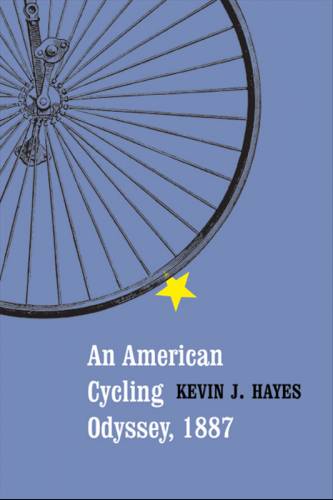 An American Cycling Odyssey, 1887
An American Cycling Odyssey, 1887
Auteur : Kevin J. Hayes
En 1887, Georges Nellis (1865-1948) un journaliste de 21 ans est parti à vélo de Herkimer, New York jusqu’à San Francisco, pendant soixante-douze jours, battant ainsi de plusieurs semaines le record de la traversée à vélo du continent. Il a parcouru en moyenne 50 miles par jour pédalant sur un grand bi « ordinaire » de la marque Columbia Expert (grande roue de 52 pouces, avec un cadre tubulaire d’acier et des pneus en caoutchouc dur) et il a perdu 23 livres (plus de 10 kilos) pendant le voyage.
Il a toujours roulé vers l’ouest à travers des villages tranquilles, des terres agricoles et des villes grandissantes d’une nation qui change rapidement ; il a fait un périple à travers des étendues de prairies inhabitées et des montagnes qui marquaient la frontière menaçante de ce périple.
Après des trajets quotidiens de dix heures, Nellis s’arrêtait et écrivait des lettres sur ses aventures à son journal et à un magazine national sur le cyclisme pour financer son voyage à travers le pays.
Le voyage épique de Nellis sur des chemins sales, des routes boueuses et parfois sur des traverses de chemin de fer, a été perturbé par un temps épouvantable, des expériences effrayantes et des rencontres étranges ; cependant il a aussi été enrichi par des splendeurs naturelles à couper le souffle et par la générosité de beaucoup de gens rencontrés. Il a failli se noyer dans une crue soudaine, a été poursuivi par un taureau furieux, a tué un coyote qui s’est approché une nuit, a été victime de mirages dans le Grand Désert Salé de l’Utah, a échappé de peu à un terrible incendie qui a anéanti la moitié d’une ville californienne, seulement quelques heures après l’avoir quittée et a été témoin d’un horrible accident sur une voie ferrée. Nellis a aussi réussi à rencontrer le légendaire joueur de baseball A. G. Spalding à Chicago, à prendre des cours de base-ball professionnel à Detroit et à Chicago, à participer à des courses cyclistes à Omaha, à assister à un opéra dans la ville de Cheyennes, dans le Wyoming, à profiter d’un cirque et à manger plus de deux douzaines de bananes lors d’une manifestation à Osceola, dans l’Indiana.
En regroupant les lettres de Nellis et les données de la couverture médiatique du voyage, Kevin J. Hayes recrée avec une précision incontestable ce périple étonnant et les nombreux visages ordinaires ou extraordinaires de l’Amérique du XIXe siècle qui ont été autrefois révélés à un jeune cycliste.
Livre en anglais, traduction d'Isabelle Reutin
2012 – 200 pages – University of Nebraska Press
Prix : $19.95
21:20 Écrit par Biblio-cycles dans Amériques, États-Unis, Histoire, Livre en anglais | Lien permanent | Commentaires (0) |  Imprimer
Imprimer
27/10/2016
Van der Plas Rob & Berto Frank
 Rebour, the bicycles illustrations of Daniel Rebour
Rebour, the bicycles illustrations of Daniel Rebour
Auteurs : Rob Van der Plas & Frank Berto
From 1945 until the early 1980s Daniel Rebour made hundreds of meticulous drawings of any and all interesting developments in the realm of bicycles. As both illustrator and technical editor of the trade magazine Le Cycle, he had the ability to show and explain all new developments, from exploded views of derailleurs and cranksets to complete bicycles and tandems. After Le Cycle was discontinued in 1973, his work mainly appeared in manufacturers' catalogues.
Ce livre en langue anglaise présente les très nombreux croquis et textes publiés par Daniel Rebour dans la revue « Le Cycle » mais aussi dans les 3 ouvrages suivants : 
-
La pratique du vélo, Paris, Technique et vulgarisation, 184 pages, 1949.
-
Cycles compétition cyclotourisme sportif, Paris, Technique et vulgarisation, 184 pages, 1962.
-
Cycles de compétition et randonneuses, Paris, Technique et vulgarisation, 188 pages, 1975, nouvelle édition réactualisée en 1976.
Daniel Rebour était aussi un fervent pratiquant de la moto comme nous le rappelle cet article du site Z'humeurs & Rumeurs
2013 – 288 pages – Cycle Publishing / Van der Plas Publications
Prix : US$ 49.95
17:55 Écrit par Biblio-cycles dans Anthologie - Traités - Essais - Biographies, Livre en anglais, Technique | Lien permanent | Commentaires (0) |  Imprimer
Imprimer
26/10/2016
Bicycle Traveler
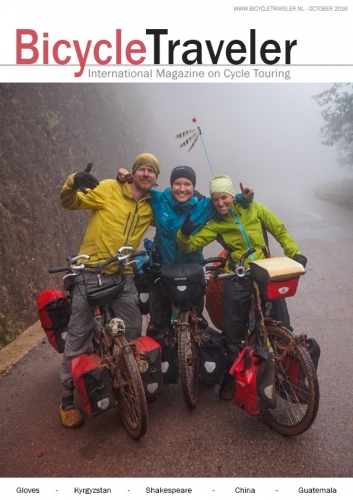 Bicycle Traveler 11
Bicycle Traveler 11
À propos du magazine
Bicycle Traveler is a free international magazine devoted to bicycle touring. Packed with stunning photography and entertaining stories, it will make you want to grab your bike and hit the road.
Bicycle Traveler was launched in 2011. We aimed to create a magazine that showcases bicycle travel and delves into why people dream of undertaking round-the-world tours.
BT’s carefully curated collection of articles and photographs are gathered from a diverse group of cycling enthusiasts worldwide. With the recent boom in bicycle touring, our magazine base has grown to over 20,000 dedicated subscribers.
As BT begins its 6th year, we are more passionate than ever about publishing high quality content that resonates with our adventure-minded readers and illustrates the wonderful world of two-wheeled travel.
In addition Bicycle Traveler also features interviews plus information on the newest gear and rider setups.
Le numéro 11
In the 11th issue we are introducing a new series, ‘Ready to Roll’ wherein riders explain their travel style and corresponding equipment choices. The idea behind this is to highlight the wide gamut of gear-setups for cyclists.
Grace Johnson - Editor of Bicycle Traveler Magazine
Commentaire de Jean-Yves Mounier
Heureux les anglophones qui peuvent lire en toute liberté ce magazine entièrement dévolu au voyage à bicyclette à travers textes et photos de toute beauté. Pour le télécharger, il suffit de s'inscrire sur le site qui offre également la possibilité de découvrir de superbes livres de photographies parmi lesquels je recommande spécialement « Little Red Cyclist » , la poésie se dégageant de ces photos m'ayant particulièrement touché.
2016 – 60 pages – En téléchargement gratuit sur le site de l'éditeur.
14:15 Écrit par Biblio-cycles dans Livre en anglais, Revue, Voyage | Lien permanent | Commentaires (1) |  Imprimer
Imprimer
26/04/2016
Hadland Tony and Lessing Hans-Erhard
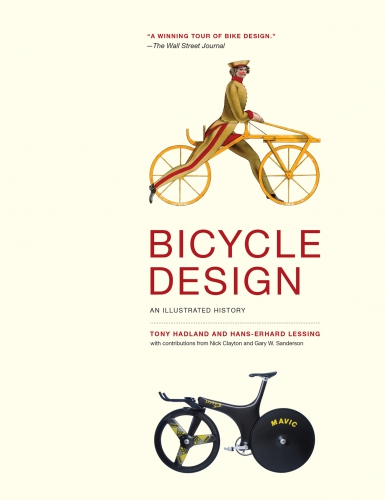 Bicycle design
Bicycle design
An illustrated History
Auteurs : Tony Hadland & Hans-Erhard Lessing
Le vélo se classe comme l'un des véhicules les plus durables et les plus largement utilisés dans le monde, avec plus d'un milliard produit au cours de deux cents ans d'histoire du cyclisme.
Ce livre propose un compte rendu complet et faisant autorité de l'évolution technique et historique de la bicyclette, dès les premiers vélocipèdes (inventés pour combler le besoin de transport sans cheval pendant une pénurie d'avoine) aux vélos de course modernes, VTT et vélos couchés.
Il retrace le développement de la bicyclette en termes de matériaux, d'ergonomie et de physique des véhicules tels qu’ils ont été réalisés par les inventeurs, les entrepreneurs et les fabricants.
Écrit par deux grands historiens du vélo et généreusement illustré de dessins historiques, de modèles et de photographies, Bicycle Design décrit les principales étapes de l'évolution de la bicyclette, à commencer par l'idée paradoxale de l'équilibre sur deux roues en ligne, par le développement de roues à rayons tenseurs, des entraînements indirects (employant des leviers, des poulies, des chaînes et des roues à chaîne), et des pneumatiques. Les auteurs examinent le prochain développement de la bicyclette à des fins spécifiques comme la course, la portabilité et l'utilisation tout-terrain ; et ils décrivent l'évolution des composants du vélo, y compris les sièges, la transmission, les freins, les feux (au début il s’agissait de lumière à base de bougies), et le transport (grilles, sacoches, sacs, sièges pour enfants, et side-cars).
Ils prennent en compte non seulement des modèles ayant eu du succès, mais aussi des échecs commerciaux qui ont ouvert la voie à des développements technologiques futurs. Et ils démystifient certains mythes au sujet des vélos, comme par exemple, l'idée erronée, mais souvent cité que Léonard de Vinci dessina dans ses carnets un vélo avec entraînement à chaîne. Malgré la longue histoire et le succès grand public de la bicyclette, son histoire technologique a été négligée. Ce livre qui traite de manière attrayante et détaillée de ce thème comble cette lacune. Ce sera le point de départ de toutes les histoires futures de la bicyclette.
Livre en anglais : traduction d'Isabelle Reutin
2014 – 584 pages – The MIT Press https://mitpress.mit.edu/books/bicycle-design
Prix : $36.95
16:36 Écrit par Biblio-cycles dans Anthologie - Traités - Essais - Biographies, Écologie-Politique-Économie, Essai, Histoire, Livre en anglais | Lien permanent | Commentaires (0) |  Imprimer
Imprimer
19/01/2016
Manser Riaan
 Around Africa on my bicycle
Around Africa on my bicycle
Auteur : Riaan Manser
In a world first, almost incredibly, Riaan Manser rode a bicycle right around the continent of Africa.
It took him two years two months and fifteen days, he rode 36,500 Km through 34 different countries.
In Around Africa on my bicycle Manser tells the story of this epic journey. It is a story of blood, sweat, toil and tears. It is a story of triumph and occasional disaster. Of nights out under the stars, of searing heat and rain, of endless miles of Africa and of pressing on and never surrendering whatever the odds.
Mostly however it is the story of one man’s courage and determination to escape the mundane and see the continent he loves and feels so much a part of. It is the story of the human warmth he encounters, and occasionally human wrath and hostility as he crosses troubled countries and bordres.
Riaan Manser was born in 1973 Pretoria. He grew up in Zululand and attended John Ross College in Richards Bay. After studying Human Resource Management he took a job in the medical industry.
He has been a lifesaver, a surfer and a rugby player. When he took to bis bicycle to ride around Africa it was a commitment to do something entirely extraordinary with his life.
He is now an author and motivational speaker – and is looking for his next adventure.
« The book is a mélange as varied, tasty and often frightening as the range of cuisine he experienced. It is bright, entertaining and insightful travel writing about a continent that sorely needs a good press.
Jean-Jacques Cornish, Africa correspondent. »
« Fascinating and unusual ... a wonderful optimism shone through.
Johon Robbie, 702 Talk Radio. »
2007- 705 pages – Éditeur : Jonathan Balls publishers – Johannesburg & Cape Town.
Disponible à la vente sur www.riaanmanser.co.za/
17:41 Écrit par Biblio-cycles dans Afrique, Livre en anglais | Lien permanent | Commentaires (0) |  Imprimer
Imprimer
10/12/2015
Norcliffe Glen
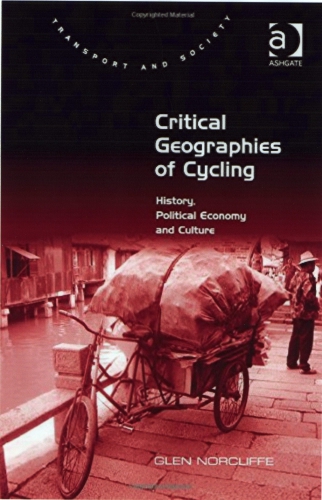 Critical Géographies of Cycling – History, Political Économy and Culture
Critical Géographies of Cycling – History, Political Économy and Culture
Auteur : Glen Norcliffe
Préface : This book presents a collection of 11 connected thematic essays. They are not intended, however, to tell a sequential tale, indeed they weave chronologically from the past to the présent and back again so that the reader may choose to read them according to individual interest without losing the thread. But they are connected by themes, by their critical stance, and their interrogation of cycle and related cycling activities. For the appearance of this book I have to thank primarily Ron Buliung at the University of Toronto, who in 2013 created a graduate course on “Geographies of Cycling“. He kindly asked me to talk to his class, and then pressed me as to how he could obtain a number of the essays that I had published. The answer was “with difficulty“, in many cases because they were published in the annual Proceedings og the International Cycle History Conference which are not widely available. Perhaps it was obvious, but it took a few weeks for the point to sink in, and then a light bulb came on and I asked Ashgate, who have an interest in both transportation and geography, whether there would be any benefit in bringing these fugitive essays together, along with a few articles I have published in more accessible journals, plus two new essays, an opening chapter to present an overview, and the final chapter to offer a geographical viewpoint on the current battle for the street. It must have been providence that guided my letter to Ashgate into the hands of their editor for Human Geography, Katy Crossan, who responded favourably to the proposal and has since patiently and creatively guide dit through various steps and hurdles.
It was also my good fortune that I was a Visiting Fellow at Fitzwilliam College, Cambridge at this time (Michaelmas Term, 2013) which allowed me to disconnect myself from many other activities and focus exclusively on research and writing. I thank the Master and Fellows of the College for this privilege. In the process, I relearned the pleasures of cycling around Britain’s most cycling friendly city, and have been able to incorporate a few of the lessons learned there into the text. But that is a recent event whereas participants at the annual International Cycling History Conference, which I have attended most years for the past two decades, have informed me about many aspects of cycling on which I was quite ill-informed, and critiqued early drafts of a number of the essays presented here. Like many other participants I have to thank Nick Clayton for launching that Conference 25 years ago.
To my mind one of the hallmarks of geography is the need to get out of our armchairs and observe things for ourselves. And if the object of our inquiry is no longer around, we seek out what people living at that time saw and wrote about it. This is not, however, a plea for rampant empiricism : theory informs the best geographical work, necessarily so since many of the key processe creating the landscape such as flows of capital, power relation, and social dynamics are often concealed . And those theoretical underpinnings need in turn to be confirmed by observing the real world : praxis and theory, and theory and praxis.
I have taken the opportunity to lightly revise the essays, and in one or two cases added  additional comment. Mostly, however, I have shortened them and dropped some of the bookish phrasing that deadens academic prose. But they do all pursue the post-structural position in viewing understandings of the bicycle as contingent upon time and place, which presents a great opportunity for geographers. The result is that widespread processes such as the rise of the E-bike, the Cyclists’ Rights Movement, and the globalization of bicycle making need to be interpreted in different ways in different places.
additional comment. Mostly, however, I have shortened them and dropped some of the bookish phrasing that deadens academic prose. But they do all pursue the post-structural position in viewing understandings of the bicycle as contingent upon time and place, which presents a great opportunity for geographers. The result is that widespread processes such as the rise of the E-bike, the Cyclists’ Rights Movement, and the globalization of bicycle making need to be interpreted in different ways in different places.
Naming everyone who helped with the writing of these essays over a 20 year period is not possible, there have deen simply too many, so I hope they will accept this broad thank-you. I am grateful to my co-authors for permitting the reproduction of essays already published. Many friends have ridden with me on long rides in Europe and North America passing on their wisdom in such brilliant places as Lithuania , and again I offer my appreciation for these extended lessons Ron Miller helped me solve mechanical problems beyond my competence and Dave Brown and many others kept me smiling when the weather turned against us. I hope that the wisdom passed on by so many friends has resulted in essays that provide insight as well as enjoyment.
2015- 275 pages, relié, format 15,9 X 23,5 – Editeur : Ashgate Publisshing Limited – Collection : Tranport and Society. http://www.ashgate.com/default.aspx?page=637&title_id...
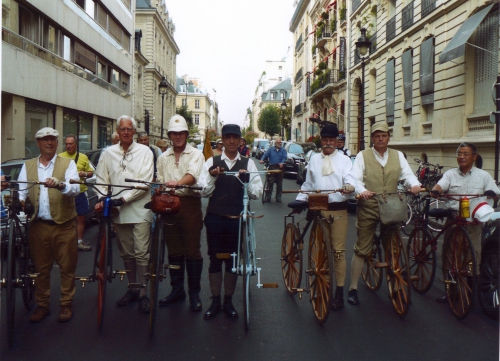
De gauche à droit : Stuart Mason-Elliott, Glen Norcliffe, Carey Williams, Gilles Tamagne, Alain Cuvier, Dominique Lefébvre, Keizo Kobayashi.
Départ du Paris -Avigon le 8 août 2015, rue Jean Goujon à paris pour commémorer le 150ème anniversaire du premier voyage à vélo du monde par les frères Olivier et Georges de la Bouglise en 1865.
16:00 Écrit par Biblio-cycles dans Anthologie - Traités - Essais - Biographies, Histoire, Livre en anglais | Lien permanent | Commentaires (0) |  Imprimer
Imprimer
08/11/2015
Guroff Margaret
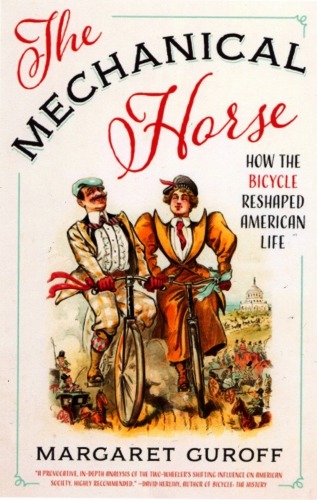 The Mechanical Horse : How the Bicycle Reshaped American Life (Discovering America)
The Mechanical Horse : How the Bicycle Reshaped American Life (Discovering America)
Auteur : Margaret Guroff
With cities across the country adding miles of bike lanes and building bikeshare stations, bicycling is enjoying a new of popularity in America. It seems that every generation or two, Americans rediscover the freedom of movement, convenience. And relative affordability of the bicycle. The earliest two-wheeler, the draisine, arrived in Philadelphia in 1819 and astonished onlookers with the possibility of propelling themselves ‘like lightning.’ Two centuries later, the bicycle is still the fastest way to cover ground on gridlocked city streets. Filled with lively stories, The Mechanical Horse reveals how the bicycle transformed American life. As bicycling caught on in the nineteenth century, many of the counytry’s rough, rutted roads were paved for the first time, laying a foundation for the interstate highway system. Cyclists were among the first to see the possibilities of self-directed, long-distance travel, and some of them (including a fellow named Henry Ford) went on to develop the automobile. Women shed their cumbersome Victorian dresses as well as their restricted gender roles, so they could ride. And which helped to modernize medicine. Margaret Guroff demonstrates that the bicycle’s story is really the story of a more mobile America, one in which physical mobilility has opened wider horizons of thought and new opportunities for people in all avenues of life.
2016- 216 pages – Publisher University of Texas Press – http://www.amazon.com/The-Mechanical-Horse-Reshaped-Disco...
Prix : 19,56 $
20:16 Écrit par Biblio-cycles dans Anthologie - Traités - Essais - Biographies, Histoire, Livre en anglais | Lien permanent | Commentaires (0) |  Imprimer
Imprimer
07/11/2015
McCullough Robert L.
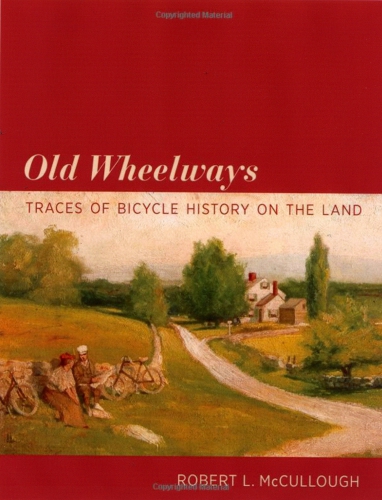 Old Wheelways
Old Wheelways
TRACES OF BICYCLE HISTORY ON THE LAND
Auteur : Robert L. McCullough
In the later part of the nineteenth century, American bicycliste were explorers, cycling through both charted and uncharted territory. These wheelmen and wheelwomen became keen observers of suburban and rural landscapes, and left copious records of their journeys – in travel narratives, journalism, maps, photographs, illustrations. They were also instrumental in the construction of roads and paths (wheelways) – building them, funding them, and lobbying legislators for them. Their explorations shaped the landscape and the way we look at it, yet with few exceptions their writings have been largely overlooked by landscape scholars, and many of the paths cyclists cleared have disappeared. In Old Wheelways, Robert McCullough restores the pioneering cyclists of the nineteenth century to the history of American landscapes. McCullough recounts marathon cycling trips around the Northeast undertaken by hardy cyclists, who then describe their journeys in such magazine as The Wheelman Illustrated and Bicycling World, the work of illustrators (including Childe Hassam, before his fame as a painter), efforts by cyclists to build better rural roads and bicycle paths, and conflicts with park planners, including the famous Olmsted firm, who often opposed separate paths for bicycles. Today’s ubiquitous bicycle lanes owe their origins to nineteenth century version, including New York City’s ‘asphalt ribbons.’ Long before there were ‘rails to trails,’there was a movement to adapt existing passageways – including aqueduct corridors, trolley rights-of-way, and canal towpaths – for bicycling. The campaigns for wheelways, McCullough piont out, offer a prologue to nearly every obstacle faced by those advocating bicycle paths and lanes today. McCullough’s text is enrichep by more than one hundred historic images of cyclists (often attired in skirts and bonnets, suits and ties), country lanes, and city streets.
2015- 384 pages – Éditions Mit Pr - http://www.amazon.com/Old-Wheelways-Traces-Bicycle-Histor...
Prix : 25,86 $
18:06 Écrit par Biblio-cycles dans Amériques, Anthologie - Traités - Essais - Biographies, Histoire, Livre en anglais | Lien permanent | Commentaires (0) |  Imprimer
Imprimer
04/11/2015
Ehmann & Klanten
 VÉLO - 2 ND GEAR
VÉLO - 2 ND GEAR
Bicycle culture and style
Éditors : S. Ehmann & R. Klanten
About this book : Choosing to ride a particular bike conveys an attitude and a way of life. Vélo-2 nd Gear illuminates and celebrates contemporary bicycle culture’s diverse scenes. From classic racing bikes to hightech speed machines, from rough fixies to fashionable city cruisers and hardworking cargo bikes, this book showcases today’s most outstanding and unusual bicycles and their riders. Vélo- 2 nd Gear not only introduces coveted manufactureres, specialized boutiques, and historical tours. It also explains how each bike-related scene cultivates its own distinct codes through the choiceof certain frames, jerseys, caps, or bags or by visiting specific events or key establishments. In doing so, the book shows why, for more and more people, bicycles have now replaced cars as the vehicles that best express their identity.
2013- 256 pages – Éditions : Gestalten – http://shop.gestalten.com
Prix : 38 €
21:50 Écrit par Biblio-cycles dans Catalogue, Écologie-Politique-Économie, Livre en anglais, Sociologie | Lien permanent | Commentaires (0) |  Imprimer
Imprimer
03/11/2015
Nicky Slade
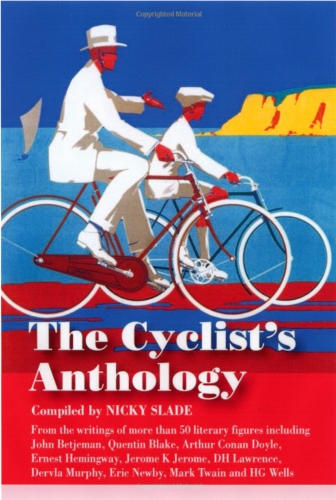 The cyclist’s anthology
The cyclist’s anthology
Compiled by : Nicky Slade
In this fascinating anthology on cycling and journeys by bicycle, Nicky Slade has drawn on the writings of more than 50 literary figures and famous personalities : J. G. Ballard, John Betjeman, Quentin Blake, Arthur conan Doyle, E. M. Forster, Ernest Hemingway, Jerome K. Jerome, D.H. Mawrence, Somerset Maugham, Dervla Murphy, Eric Newby, Dorothy Sayers, Mark Twain, H.G. Wells and Tour de France winner Bradley Wiggins among many Others.
2015- 160 pages. Ed : Trailblazer Publications. http://www.trailblazer-guides.com
Prix : 14,60 €
18:27 Écrit par Biblio-cycles dans Anthologie - Traités - Essais - Biographies, Livre en anglais | Lien permanent | Commentaires (0) |  Imprimer
Imprimer
01/09/2015
Street Roger
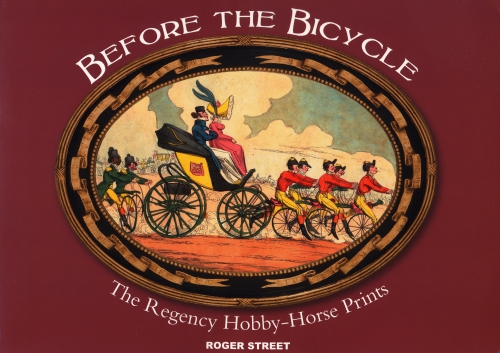
BEFORE THE BICYCLE
The Regency Hobby-Horse Prints
Auteur : Roger Street
The hobby-horse velocipede was all the rage in the spring and summer of 1819, dozens could be seen at any one time in London and elsewhere. This was the earliest form of personal transport on wheels, pre-dating the bicycle by more than forty years. The machine’s novelty ensured that it was of very general interest, but in some places it was ridiculed, particularly when ridden by the smart young genthemen of the day, the Regency dandies.
The Prince Regent himself owned four hobby-horse velocipedes.
In only a few months, some eighty hobby-horse prints were produced by a variety of artists and publisshers, some depicting the hobby-horse and its derivatives in a favourable light, others gently mocking the craze. For the very first time this book displays colour reproductions of all the hobby-horse prints for a twenty-first century spectator to view, with an explanatory note for each print. A brief introduction at the beginning of the book discusses the history of the pedestrian hobby-horse phenomena, and aspects of the many prints to which it gave rise. A foreword by Regency historian Kathryn Kane provides a wider historical perspective.
This is not just a book for the cycle historian to have in his library. It is a panorama of magnificent, colourful, and sometimes slightly rude, images for everyone to enjoy.`
2014- 174 pages, format 21 X 29,50 – Artesius Publications .
Prix : 30 €
04:12 Écrit par Biblio-cycles dans Gravure, Livre en anglais | Lien permanent | Commentaires (0) |  Imprimer
Imprimer
03/06/2015
100 years of bicycle posters
100 YEARS OF BICYCLE POSTERS
Auteur : Jack Rennert
Texte en anglais, 112 pages, reproductions en couleurs et en noir et blanc , en pleine page.
1973- 112 pages -format In-4 (40,5x28 cm) Éditions Harper & Row, Publishers, New York, Evanston, San Francisco, London.
05:37 Écrit par Biblio-cycles dans Affiches, Histoire, Illustrations, Livre en anglais | Lien permanent | Commentaires (1) |  Imprimer
Imprimer
18/04/2015
Schwinn Bicycle Company
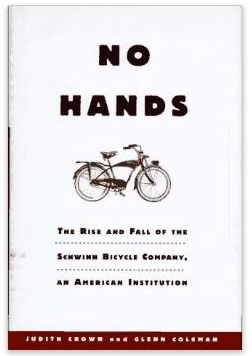 NO HANDS – The Rise and Fall of the Schwinn Bicycle Company, an American Institution
NO HANDS – The Rise and Fall of the Schwinn Bicycle Company, an American Institution
Auteurs : Judith Crown – Glenn Coleman
Langue : Anglais
Retour sur l'une des plus emblématiques marques américaines de vélo...
Pour des générations d'américains, il n'y avait pas de meilleur vélo qu'un Schwinn.
La compagnie, fondée en 1895 par Adolph Arnold et Ignaz Schwinn à Chicago (à l'époque nommée « The Arnold, Schwinn & Company of Chicago »), de par sa qualité de conception et son innovation, a eu une influence conséquente sur le marché du cycle nord-américain une bonne partie du XXe siècle.
Ignaz Schwinn, dont le nom de famille est devenu un acronyme de vélo là-bas, arriva aux États-Unis avec pour simple richesse son savoir-faire en terme de manufacture industrielle, acquis en tant qu'ouvrier immigrant apprenti machiniste dans les usines allemandes.
Entre 1900 et 1930, Schwinn a produit approximativement 45 000 vélos chaque année, dans un marché très fluctuant et dont la Grande Dépression a vu de nombreuses usines du secteur fermer leurs portes pour de bon.
L'influence de Frank W. Schwinn va définitivement façonner la manière dont on conçoit un vélo aux États-Unis. Il pousse les fabricants de composants à concevoir des pièces plus solides et plus durables, il introduit les gardes-boues ou encore les fameux pneus ballons.
En 1941, ce sont plus de 340 000 vélos qui sortent des lignes de production Schwinn, et en 1950, un vélo sur quatre fabriqué aux USA est un Schwinn ! Le modèle haut-de-gamme Black Phantom va vite devenir un must-have chez les minots de cette période, avec ses détails chromés et sa garantie à vie.
L'influence de Schwinn a également beaucoup changé la manière de vendre les vélos. En 1948, terminé les vélos vendus dans les grandes chaînes de magasin, Schwinn veut se servir de sa réputation pour vendre autrement. S'en suit alors une politique marketing et commerciale très agressive. La compagnie pousse les détaillants à faire allégeance à leur marque et à vendre exclusivement des modèles Schwinn à leur clientèle. Elle se concentre aussi sur le levier publicitaire, en utilisant les étoiles montantes du moment pour faire la promotion de leurs modèles
1963 voit l'introduction de l'iconique modèle Stingray, une réponse directe au non moins célèbre Raleigh Chopper qui cartonne chez les jeunes, avec son guidon en hauteur et son siège banane.
Mais ce succès se révélera malheureusement éphémère. Alors que Schwinn s'imposait comme la marque qui comptait dans les années 70, une usine vieillissante et une direction réticente à embrasser les tendances alors naissantes du BMX et du VTT, auront eu raison de cette réussite.
En 1993, la société est revendue et quittera le marché du vélo haut-de-gamme pour celui de la grande distribution. Pour autant, la marque semble depuis quelques années renaître petit à petit de ses cendres sur le sol US.
Extraits de l'article paru sur le site : Weelz.fr - http://www.weelz.fr/fr/velo-urbain/2015/04/14/histoire-sc...et avec son accord.
Des catalogues de cette marque sont également consultables ici : http://schwinncruisers.com/catalogs/
1996- 350 pages –Éditeur : Henry Holt & Co –
19:24 Écrit par Biblio-cycles dans Anthologie - Traités - Essais - Biographies, Écologie-Politique-Économie, Histoire, Les États-Unis du Nord, Livre en anglais | Lien permanent | Commentaires (0) |  Imprimer
Imprimer
18/03/2015
Murphy Dervla
 THE UKIMWI ROAD
THE UKIMWI ROAD
From Kenya to Zimbabwe
Dervla Murphy must be the toughest female travel writer of our age. One turns the page only twice in this latest book before finding her beaten by club-wielding paramilitary troopers as she flees a protest rally in Nairobi. And almost its final image is of her alone in the middle of the Zimbabwean bush, 40 miles from the nearest doctor, exhausted, prostrate, head cushioned on an elephant turd - all the consequence of a severe malaria attack. Yet, the 3,000 miles between these two fraught moments were covered on a bicycle which she bought on her 60th birthday. . .
http://www.dervlamurphy.com/theukimwiroad.html
1993- 288 pages -
 South from the LIMPOPO
South from the LIMPOPO
TRAVELS THROUGH SOUTH AFRICA
When Dervla Murphy first pedalled across the Limpopo she fancied that she ‘understood’ South Africa’s problems because for more than forty years she had – from a distance – taken a particular interest in them. Twelve hours later that illusion was shattered.
South from the Limpopo reflects her moods of confusion and elation, hope and disappointment as she tries to come to terms with a country even more complex and fractured – but also more flexible – than she had expected. Her journey of over 6,000 miles took her through all nine provinces of the new South Africa. From remote impoverished ex-homeland villages, to the luxurious homes of rich whites, the scruffy homes of poor whites and in the black township of Khayelitsha, Dervla experienced the contrasting social conditions of South Africa’s people. Dervla Murphy bicycled alone through this extraordinary and haunting nation during a period of great uncertainty and tumultuous change (before, during and after the elections) with her remarkable ability to mix and share with people of all colours, creeds and political persuasions, she provides a unique perspective on South Africa with its apparently insoluble problems and desperate inequalities – a country she truly came to love.
1997- 432 pages –
http://www.dervlamurphy.com/southfromthelimpopo.html
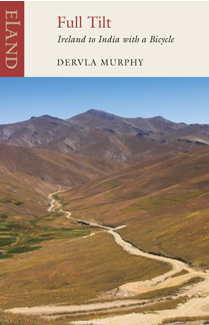 FULL TILT : Ireland to India with a bicycle
FULL TILT : Ireland to India with a bicycle
When Dervla Murphy was ten, she was given a bicycle and an atlas, and within days she was secretly planning a trip to India. At the age of thirty-one, in 1963, she finally set off and this book is based on the daily diary she kept while riding through Persia, Afghanistan and aver the Himalayas to Pakistan and India.
Alone woman on a bicycle (with a revolver in her trouser pocket) was an almost unknown occurrence and a focus of enormous interest wherever she went. Undaunted by snow in alarming quantites, and using her .25 pistol on starving wolves in Bulgaria and to scare lecherous Kurds in Persia, her resourcefulness and the blind eye she turned to personal danger and extreme discomfort were remarkable.
2010- 256 pages – Éditions ELAND www.travelbooks.co.uk/b#1DB0C97
Prix : £ 12.99
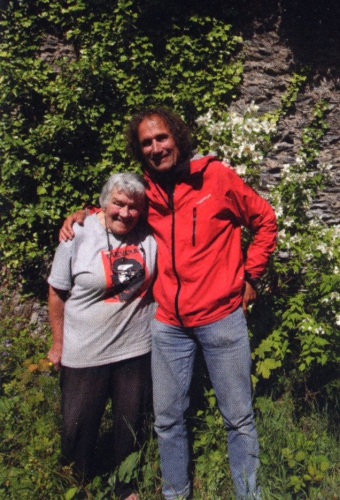 Extrait de l’article paru dans “Cycle ! magazine 3 “ www.rossolis.ch
Extrait de l’article paru dans “Cycle ! magazine 3 “ www.rossolis.ch
DERVLA MURPHY, UNE PENSÉE EN ROUE LIBRE
(photo: Dervla Murphy et Claude Marthaler)
Lismore, 27 juin 2014
Nous sommes à Lismore, à quelques heures de route de Dublin et venons de frapper à la porte d’une grande dame, qui n’a pas perdu une once de passion en poursuivant son petit bonhomme de chemin. Elle nous accueille par une énergique poignée de main et un « Une bière ? ». S’éclipse et s’en revient, empoignant trois canettes fraîches, suivie par ses trois chiens,dont l’un s’appelle Guinness, comme la bière qu’elle apprécie. Dervla prend le temps de recevoir, avec le sourire et à la bonne franquette. Elle n’est pas du genre à s’embarrasser de formalités. Pain maison, olives, bière et ginger ale. Tout y est brut et délicieux à la fois, sans manières ni faux-semblants. Le thé aussi coule à profusion, Dervla veille à ce que nos verres soient pleins. Il fallait s’y attendre, la conversation nous entraînera loin de Lismore, très loin et dans toutes les directions. Elle est comme ça Dervla. Intrépide, émerveillée. Sacrée Dervla !
En matière d’interview, c’est elle qui me pose des questions, le regard vif, éclatant volontiers de rire, curieuse de tout, de connaître nos avis. Tempérament sanguin. La simplicité même liée à l’érudition. Cheveux courts, masculine. Sa voix rauque trahit un excès d’alcool, de cigarettes et de café. Elle tient sa révolte et son érudition de son père bibliothécaire, un fier indépendantiste, autrefois proche de l’IRA. Sa mère, malgré sa maladie dégénérative ne s’est jamais plainte et l’a beaucoup encouragée. « C’était ma grande ambition d’écrire. Il est important de savoir jeune ce qu’on sait faire et d’accepter ses limites. Je n’ai par exemple aucun talent pour les langues étrangères ou la photographie, qui ne sert que de notes à ma mémoire. » « J’ai le privilège de vivre de ce que j’aime », ajoute-t-elle. « Avec l’âge, cela devient de plus en plus dur d’écrire. Ma fille me seconde et s’occupe de l’editing ».
Dervla s’émerveille en feuilletant mon livre de photos (Dans la roue du monde). Lorsque je lui demande ce qui fait un bon livre de voyage, elle n’évoque pas le style, mais dit simplement : « Pour un bon récit de voyage, il faut s’éloigner des routes. Moins on possède d’argent, plus on est en contact avec le pays. Lorsqu’on voyage seul, on est en totale dépendance, c’est un bon départ car on montre aux autres qu’on leur fait confiance. » À l’opposé de jeunes écrivains de voyage qui aiment à mélanger réalité et fiction, elle pense qu’un auteur de récits de voyage doit s’en tenir aux seuls faits. Mélanger fiction et réalité n’est pas une bonne idée, parce que les générations futures risquent de prendre ces récits comme des témoignages historiques. Ou alors, il faut clairement avertir le lecteur. En effet, donner de l’importance à la mémoire est une question de responsabilité. Claude Marthaler
http://www.dervlamurphy.com/books.html
20:17 Écrit par Biblio-cycles dans Afghanistan, Afrique, Himalaya, Inde, Livre en anglais, Pakistan | Lien permanent | Commentaires (1) |  Imprimer
Imprimer
17/10/2014
Heine Jan - Pradères Jean-Pierre
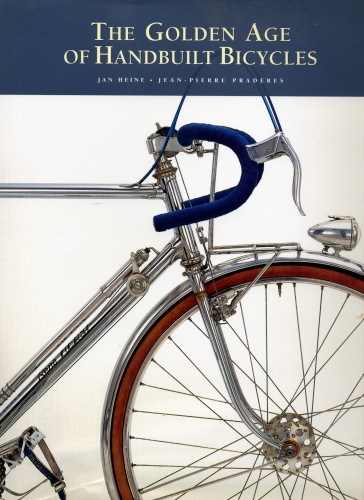
The Golden Age of Handbuilt Bicycles.
L’âge d’or des bicyclettes artisanales.
Auteurs : Jan Heine - Photography : Jean-Pierre Pradères
The 50 classic bicycles in this book display amazing craftsmansship, élégance and function. Each brought innovations that continue to de used today.
With renewed inter est in « real world » bicycles that combine the speed and excitement of racing bikes with unmatched reliability and versatility « The Golden Age of Handbuilt Bicycles » provides a timely review of what bicycles can be.
Une brochure en français, traduction du livre est vendue avec l’ouvrage.
Ce magnifique livre nous relate un demi-siècle de ces fabricants artisans novateurs du vélo, et en devient un ouvrage indispensable pour mieux comprendre l’histoire de la bicyclette.
Jean-Pierre Pradères nous offre avec ces cent cinquante photos de ces belles machines un véritable livre d’art.
-2005- 167 pages - Paris - Jean-Pierre Pradères 26, rue des Maraîchers – 75020 Paris.
Prix : 50€ port compris
Va être réédité en février 2015 chez Éditions Rizzoli
18:00 Écrit par Biblio-cycles dans Anthologie - Traités - Essais - Biographies, Catalogue, Livre en anglais | Lien permanent | Commentaires (0) |  Imprimer
Imprimer
03/07/2014
Zheutlin Peter
 Around the world on two wheels
Around the world on two wheels
Annie Londonderry’s Extraordinary Ride
Auteur : Peter Zheutlin
« Peter Zheutlin’s thoroughly researched account wil make you wish you’d been around to catch a glimpse of the extraordinary woman as she went wheeling by. »
Bill Littlefield, National Public Radio’s Only a Game.
Until 1894 there were no female sport staes, no product endorsement deals, and no young mothers with the chutzpah to circle the globe on a bicycle.
Annie Londonderry changed all of that.
When Annie left Boston in june of that year, she was a brash young lady with a 42 pound bicycle, a revolver, a change of underwear, and a dream of freedom. She was also a feisty mother of three who had become the center of what one newspaper called “one of the most novel wagers ever made“ : a high-stakes bet between two wealthy merchants that a woman could not ride around the world on a bicycle. The epic journey that followed took the connection between athletics and commercialism to dizzying new heights, and turned Annie Londonderry into a symbol of women’s equality.
A vastly entertaining blend of social history, high adventure, and maverick marketing. Atound World on Wheel sis an unforgettable portrait of courage, imagination, and tenacity.
“Annie was a remarkable woman and well worth getting to know.“
Booklist
“A wonderful telling of one of the most intriguing, offbeat, and until now, lost chapters in the history of cycling.“
2007 – 260 pages – Citadel
Pour en savoir plus, voir le site que l'auteur consacre à son héroïne.
Lire l'article de Claude Marthaler paru dans La Liberté et Annie Londonderry, ou le premier tour du monde féminin à vélo (pp. 143-147) in A tire-d'Elles,Femmes, vélo et liberté
Un article très complet sur le site "Le petit braquet".
Annie Londonderry a également inspiré le collectif cyclo-féministe "Les dérailleuses" pour son fanzine.
20:03 Écrit par Biblio-cycles dans Anthologie - Traités - Essais - Biographies, Histoire, Livre en anglais, Tour du Monde | Lien permanent | Commentaires (2) |  Imprimer
Imprimer
22/04/2014
Sutherland Louise
 Spinning the Globe
Spinning the Globe
Auteur : Louise Sutherland
Louise was a small woman with a big heart. She knew virtually nothing about bicycles, except what really mattered, and so became a cycling legend without winning a single race. Instead Louise Sutherland planned her own route – one that was far longer and rougher than any Tour de France. She was the first person ever to cycle right across Brazil, through the Amozon Jungle.
-2013- 101 pages – Kindle Editions
http://www.kennett.co.nz/shop/
Price : $ 20
08:27 Écrit par Biblio-cycles dans Livre en anglais, Tour du Monde | Lien permanent | Commentaires (0) |  Imprimer
Imprimer
29/03/2014
Tom Phillips

BICYCLES – Vintage people on photo postcards
Auteur : Tom Phillips
Langue : Anglais – Une sélection de 200 cartes postales vélo des années 1890 à 1950.
-2011- 112 pages, format 19,6 x 18,2 – Éditeur : The Bodleian Library. http://www.bookdepository.com/contactus
Prix : 26,60 € + 2,99 de frais port.
08:38 Écrit par Biblio-cycles dans Histoire, Livre en anglais, Philosophie | Lien permanent | Commentaires (0) |  Imprimer
Imprimer
20/09/2011
Vanman Cécilia
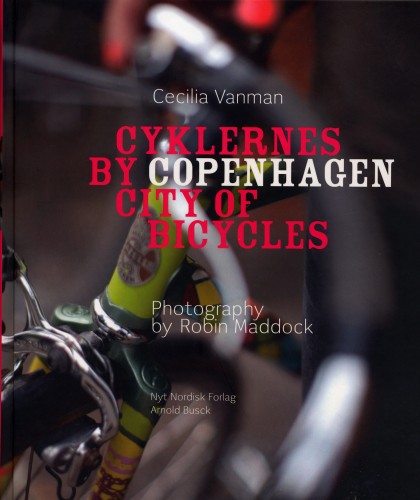 CYKLERNES BY COPENHAGEN - CYTY OF BICYCLES
CYKLERNES BY COPENHAGEN - CYTY OF BICYCLES
Auteur : Cécilia Vanman
Photography : Robin Maddock
Livre bilingue : Danois -Anglais
Présentation traduite par Ulla Einersen.
Au Danemark tout le monde se déplace à bicyclette. Même le prince héritier se promène souvent avec ses enfants dans un tricycle-livreur et c’est normal de voir un parlementaire parquer son vélo devant le parlement ou un acteur traverser le centre ville avec son filet à provisions suspendu au guidon. Les habitants de Copenhague expriment leur style et leur individualité dans leur choix de vélo. On pédale avec des chaussures à talon, côte à côte à sur la piste cyclable les amies mènent de longues conversations et avec une main sur le guidon on envoie des SMS avec l’autre, on parle au téléphone, boit du café, écoute la musique ou transporte les chiens, les enfants et d’innombrables filets de provisions - le tout sur deux roues. Les habitants de Copenhague vivent pratiquement sur leur vélo et la ville est pleine de vendeurs et de réparateurs de vélo, de gens qui fabriquent eux-mêmes leurs vélos, de collectionneurs et de toutes sortes de bicyclettes.
Avec la focalisation croissante sur la santé, l’exercice corporel et le développement durable, le monde focalise sur l’utilisation du vélo au Danemark.
 Les urbanistes du monde entier vont à Copenhague pour voir de leurs propres yeux comment la bicyclette peut s’intégrer d’une façon naturelle dans la vie d’une métropole.
Les urbanistes du monde entier vont à Copenhague pour voir de leurs propres yeux comment la bicyclette peut s’intégrer d’une façon naturelle dans la vie d’une métropole.
Dans son livre - LA VILLE DES BICYCLETTES - (Cyklernes by) CéciliaVanman nous donne une description engagée des multiples aspects de la cyclo-culture des Danois, en collaboration avec le photographe britannique Robin Maddock dont les photos ajoutent la fascination d’un étrange vis à vis de la capitale des bicyclettes.
 Cécilia Vanman : Biologist and journalist. Her main boby of work focused on natural history and travel adventure. Amongst Other ways, she has conveyed these subject matters through reportage work on film expeditions in the Canadian High Arctic and travels in northeastern Greenland with the Danish elite unit Sirius Sledge Patrol. Cécilia lives in the Christianshavn quarter in Copenhagen and rides a vintage men’s bicycle, which will soon be joined by a custom-built racer.
Cécilia Vanman : Biologist and journalist. Her main boby of work focused on natural history and travel adventure. Amongst Other ways, she has conveyed these subject matters through reportage work on film expeditions in the Canadian High Arctic and travels in northeastern Greenland with the Danish elite unit Sirius Sledge Patrol. Cécilia lives in the Christianshavn quarter in Copenhagen and rides a vintage men’s bicycle, which will soon be joined by a custom-built racer.
-2010- 195 pages - format 21,50 X 25,50 - Nyt Nordisk Forlag Arnold Busck A/S - Landemaerket 11, 5. Sal - 1119 Kobenhavn K
www.nytnordiskforlag.dk - nnf@nytnordiskforlag.dk
Prix : 50 €
15:02 Écrit par Biblio-cycles dans Écologie-Politique-Économie, Livre en anglais | Lien permanent | Commentaires (1) |  Imprimer
Imprimer



